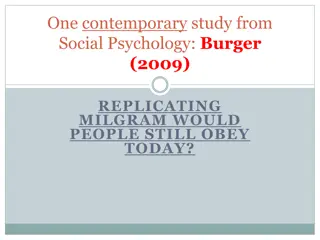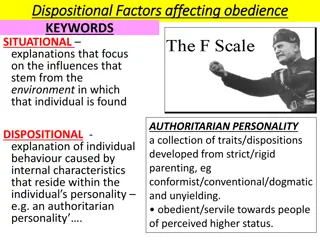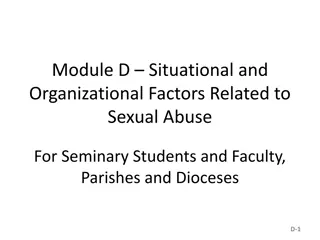Understanding Attribution Theory: Exploring Dispositional vs. Situational Attribution
Attribution theory examines how people explain behavior and events by analyzing internal vs. external causes. Heider's influential ideas on dispositional vs. situational attributions are discussed. Dispositional attribution focuses on internal characteristics, while situational attribution relates behavior to external factors. Accidental vs. intentional behavior and social desirability also influence attributions.
Download Presentation

Please find below an Image/Link to download the presentation.
The content on the website is provided AS IS for your information and personal use only. It may not be sold, licensed, or shared on other websites without obtaining consent from the author. Download presentation by click this link. If you encounter any issues during the download, it is possible that the publisher has removed the file from their server.
E N D
Presentation Transcript
Attribution-Meaning ,frame of reference, sterotyping SESSION 31 Dr. Chitrasena Padhy Associate Professor Agricultural Extension
Attribution theory is concerned with how ordinary people explain the causes of behavior and events. For example, is someone angry because they are bad- tempered or because something bad happened? A formal definition is provided by Fiske and Taylor (1991, p. 23): Attribution theory deals with how the social perceiver uses information to arrive at causal explanations for events. It examines what information is gathered and how it is combined to form a causal judgment .
Heider (1958) believed that people are naive psychologists trying to make sense of the social world. People tend to see cause-and-effect relationships, even where there is none! Heider didn t so much develop a theory himself to emphasize certain themes that others took up. There were two main ideas that he put forward that became influential: dispositional (internal cause) vs. situational (external cause) attributions.
Dispositional Vs Situational Attribution 1. Dispositional Attribution Dispositional attribution assigns the cause of behavior to some internal characteristic of a person rather than to outside forces. When we explain the behavior of others, we look for enduring internal attributions, such as personality traits. This is known as the fundamental attribution error. For example, we attribute the behavior of a person to their personality, motives, or beliefs.
2. Situational Attribution The process of assigning the cause of behavior to some situation or event outside a person s control rather than to some internal characteristic. When we try to explain our behavior, we tend to make external attributions, such as situational or environmental features. Choice: If the behavior is freely chosen, it is believed to be due to internal (dispositional) factors.
Accidental vs. Intentional Behavior: Behavior that is intentional is likely to be attributed to the person s personality, and behavior which is accidental is likely to be attributed to situation / external causes. Social Desirability: Behaviors low in sociable desirability (non-conforming) lead us to make (internal) dispositional inferences more than socially undesirable behaviors. For example, if you observe a person getting on a bus and sitting on the floor instead of one of the seats. This behavior has low social desirability (non- conforming) and is likely to correspond with the personality of the individual.
Hedonistic Relevance: If the other persons behavior appears to be directly intended to benefit or harm us. Personalism: If the other person s behavior appears to be intended to have an impact on us, we assume that it is personal and not just a by- product of the situation we are both in.
Kelleys Covariation Model Kelley s (1967) covariation model is the best-known attribution theory. He developed a logical model for judging whether a particular action should be attributed to some characteristic (dispositional) of the person or the environment (situational). More specifically, they take into account three kinds of evidence: Consensus: The extent to which other people behave in the same way in a similar situation. E.g., Alison smokes a cigarette when she goes out for a meal with her friend. If her friend smokes, her behavior is high in consensus. If only Alison smokes, it is low.
Distinctiveness: The extent to which the person behaves in the same way in similar situations. If Alison only smokes when she is out with friends, her behavior is high in distinctiveness. If she smokes at any time or place, her distinctiveness is low. Consistency: The extent to which the person behaves like this every time the situation occurs. If Alison only smokes when she is out with friends, consistency is high. If she only smokes on one special occasion, consistency is low.
Lets look at an example to help understand his particular attribution theory. Our subject is called Tom. His behavior is laughter. Tom is laughing at a comedian. 1. Consensus If everybody in the audience is laughing, the consensus is high. If only Tom is laughing, the consensus is low. 2. Distinctiveness If Tom only laughs at this comedian, the distinctiveness is high. If Tom laughs at everything, then distinctiveness is low
3. Consistency If Tom always laughs at this comedian, the consistency is high. If Tom rarely laughs at this comedian, then consistency is low. Now, if everybody laughs at this comedian if they don t laugh at the comedian who follows, and if this comedian always raises a laugh, then we would make an external attribution, i.e., we assume that Tom is laughing because the comedian is very funny.
On the other hand, if Tom is the only person who laughs at this comedian, if Tom laughs at all comedians, and if Tom always laughs at the comedian, then we would make an internal attribution, i.e., we assume that Tom is laughing because he is the kind of person who laughs a lot. According to Kelley, we fall back on past experience and look for either
1) Multiple necessary causes. For example, we see an athlete win a marathon, and we reason that she must be very fit, highly motivated, have trained hard, etc., and that she must have all of these to win 2) Multiple sufficient causes. For example, we see an athlete fail a drug test, and we reason that she may be trying to cheat, or have taken a banned substance by accident, or have been tricked into taking it by her coach. Any one reason would be sufficient























